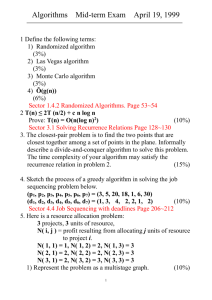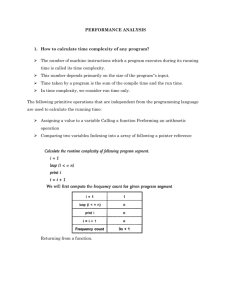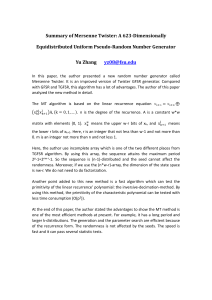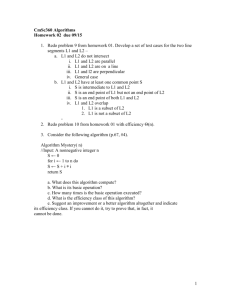Recurence Relations
advertisement
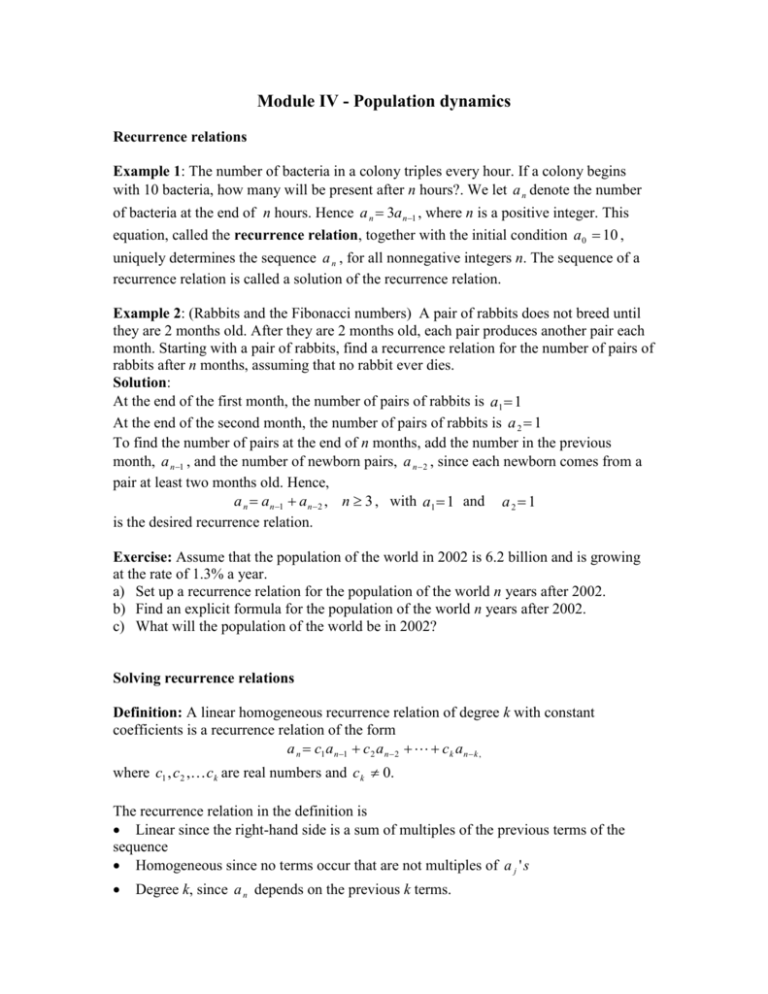
Module IV - Population dynamics
Recurrence relations
Example 1: The number of bacteria in a colony triples every hour. If a colony begins
with 10 bacteria, how many will be present after n hours?. We let a n denote the number
of bacteria at the end of n hours. Hence a n 3a n1 , where n is a positive integer. This
equation, called the recurrence relation, together with the initial condition a0 10 ,
uniquely determines the sequence a n , for all nonnegative integers n. The sequence of a
recurrence relation is called a solution of the recurrence relation.
Example 2: (Rabbits and the Fibonacci numbers) A pair of rabbits does not breed until
they are 2 months old. After they are 2 months old, each pair produces another pair each
month. Starting with a pair of rabbits, find a recurrence relation for the number of pairs of
rabbits after n months, assuming that no rabbit ever dies.
Solution:
At the end of the first month, the number of pairs of rabbits is a1 1
At the end of the second month, the number of pairs of rabbits is a 2 1
To find the number of pairs at the end of n months, add the number in the previous
month, a n1 , and the number of newborn pairs, a n 2 , since each newborn comes from a
pair at least two months old. Hence,
a n an1 an2 , n 3 , with a1 1 and a 2 1
is the desired recurrence relation.
Exercise: Assume that the population of the world in 2002 is 6.2 billion and is growing
at the rate of 1.3% a year.
a) Set up a recurrence relation for the population of the world n years after 2002.
b) Find an explicit formula for the population of the world n years after 2002.
c) What will the population of the world be in 2002?
Solving recurrence relations
Definition: A linear homogeneous recurrence relation of degree k with constant
coefficients is a recurrence relation of the form
a n c1 a n 1 c 2 a n 2 c k a n k ,
where c1 , c2 , ck are real numbers and ck 0.
The recurrence relation in the definition is
Linear since the right-hand side is a sum of multiples of the previous terms of the
sequence
Homogeneous since no terms occur that are not multiples of a j ' s
Degree k, since a n depends on the previous k terms.
The coefficients of the terms are constants.
Note: A sequence satisfying the recurrence relation in the definition is uniquely
determined by this recurrence relation and the k initial conditions
a 0 b0 , a2 b2 ,...ak 1 bk 1 .
Theorem 1: Let c1 , c2 , ck be real numbers. Suppose the characteristic equation
r k c1 r k 1 c k 0
has k distinct roots r1 , r2 , rk . Then a sequence {a n } is a solution of the recurrence
relation
an c1an1 c2 an2 ck ank
if and only if
a n p1 r1n p 2 r2n p k rnn
for n 0,1,2, where p1 , p2 , pk are constants.
Theorem 2: Let c1 , c2 , ck be real numbers. Suppose the characteristic equation
r k c1 r k 1 c k 0
has t distinct roots r1 , r2 , rt with multiplicities m1 , m2 , mt respectively, so that mi 1
for i 1,2, , t and m1 m2 mt k . Then a sequence {a n } is a solution of the
recurrence relation
an c1an1 c2 an2 ck ank
if and only if
m 1
an ( p1,0 p1,1n p1,m 1n 1 )r1n
1
m 1
+ ( p2,0 p2,1n p2,m 1n 2 )r2n
2
mt 1 n
+ ( p p n p
n
)rt
t ,0
t ,1
t ,mt 1
for n 0,1,2, where pi, j are constants for 1 i t and 0 j mt 1
Solving a recurrence relation:
Example: Solve the recurrence relation satisfied by the Fibonacci sequence:
a n an1 an2 , n 2 , with a 0 0 and a1 1
We look for solution of the form a n r n
Substituting into the recurrence relation and simplifying we get the characteristic
1 5
1 5
, r2
equation r 2 r 1 0 . The characteristic roots are r1
.
2
2
Therefore
n
n
1 5
1 5
p2
a n p1
2
2
Substituting the initial conditions we get a system of linear equation which are uniquely
solvable giving p1 1 / 5 , p 2 1 / 5
Exercise: What is the solution of the recurrence relation
a n 5an1 6an2 , n 2 , with a 0 1 and a1 6 ?
Reference: Discrete Mathematics and its application by Rosen, 5th edition
The discrete logistic model
Consider a sequence of discrete times t 0 , t1 , t 2 where t n 1 t n h for each n, and h > 0
is a fixed step size (the interval between successive breeding seasons). Let P denote the
population at any time t and let P0 P(t 0 ), P1 P(t1 ), P2 P(t 2 ),. The Discrete
logistic model is given by the non-linear recurrence relation:
Pn1 Pn (aPn bPn2 ) h ,
a, b 0
This equation can be rewritten as the logistic difference equation
Pn1 rPn sPn2 , with
r 1 ah , and s bh
The substitution
r
Pn x
s n
simplifies the equation to
xn1 rx n (1 x )
n
Beginning with given values of x 0 and r, the last formula generates a sequence x1 , x2 ,
of values corresponding to the successive times t1 , t 2 , . We may think of x n , the value
at time t n , as the fraction of the maximum population that the environment can support.
Assuming
x lim x n
n
exists, we want to investigate the way in which x depends on the growth parameter,
r. Because r 1 ah , only values of r greater than 1 are pertinent to our idealized model
of population growth. It turns out that the value of x n generally appears to stabilize on a
limiting value x and the number of iterations depends on the value of r and not on the
initial value.
Example: with growth rate r =1.5, and x1 0.5 , using Maple we get the following for n =
50:
> r:=1.5:
> x=array(1..50):
> x[1]:=0.5:
> for n from 2 to 50 do z:=x[n-1]:
> x[n]:=r*z*(1-z):
> od;
z := 0.5
x2 := 0.375
z := 0.375
x3 := 0.3515625
z := 0.3515625
x4 := 0.3419494629
z := 0.3419494629
x5 := 0.3375300416
z := 0.3375300416
x6 := 0.3354052689
z := 0.3354052689
x7 := 0.3343628618
z := 0.3343628618
x8 := 0.3338465077
z := 0.3338465077
x9 := 0.3335895255
z := 0.3335895255
x10 := 0.3334613309
z := 0.3334613309
x11 := 0.3333973076
z := 0.3333973076
x12 := 0.3333653143
z := 0.3333653143
x13 := 0.3333493222
z := 0.3333493222
x14 := 0.3333413274
z := 0.3333413274
x15 := 0.3333373303
z := 0.3333373303
x16 := 0.3333353318
z := 0.3333353318
x17 := 0.3333343326
z := 0.3333343326
x18 := 0.3333338330
z := 0.3333338330
x19 := 0.3333335832
z := 0.3333335832
x20 := 0.3333334583
z := 0.3333334583
x21 := 0.3333333958
z := 0.3333333958
x22 := 0.3333333646
z := 0.3333333646
x23 := 0.3333333490
z := 0.3333333490
x24 := 0.3333333412
z := 0.3333333412
x25 := 0.3333333373
z := 0.3333333373
x26 := 0.3333333353
z := 0.3333333353
x27 := 0.3333333343
z := 0.3333333343
x28 := 0.3333333338
z := 0.3333333338
x29 := 0.3333333336
z := 0.3333333336
x30 := 0.3333333335
z := 0.3333333335
x31 := 0.3333333334
z := 0.3333333334
x32 := 0.3333333334
z := 0.3333333334
x33 := 0.3333333334
z := 0.3333333334
x34 := 0.3333333334
z := 0.3333333334
x35 := 0.3333333334
z := 0.3333333334
x36 := 0.3333333334
z := 0.3333333334
x37 := 0.3333333334
z := 0.3333333334
x38 := 0.3333333334
z := 0.3333333334
x39 := 0.3333333334
z := 0.3333333334
x40 := 0.3333333334
z := 0.3333333334
x41 := 0.3333333334
z := 0.3333333334
x42 := 0.3333333334
z := 0.3333333334
x43 := 0.3333333334
z := 0.3333333334
x44 := 0.3333333334
z := 0.3333333334
x45 := 0.3333333334
z := 0.3333333334
x46 := 0.3333333334
z := 0.3333333334
x47 := 0.3333333334
z := 0.3333333334
x48 := 0.3333333334
z := 0.3333333334
x49 := 0.3333333334
z := 0.3333333334
x50 := 0.3333333334
It can be verified that for r = 1.5, 2.0, and 2.5, x 0.333333, 0.5, and 0.6
respectively.


